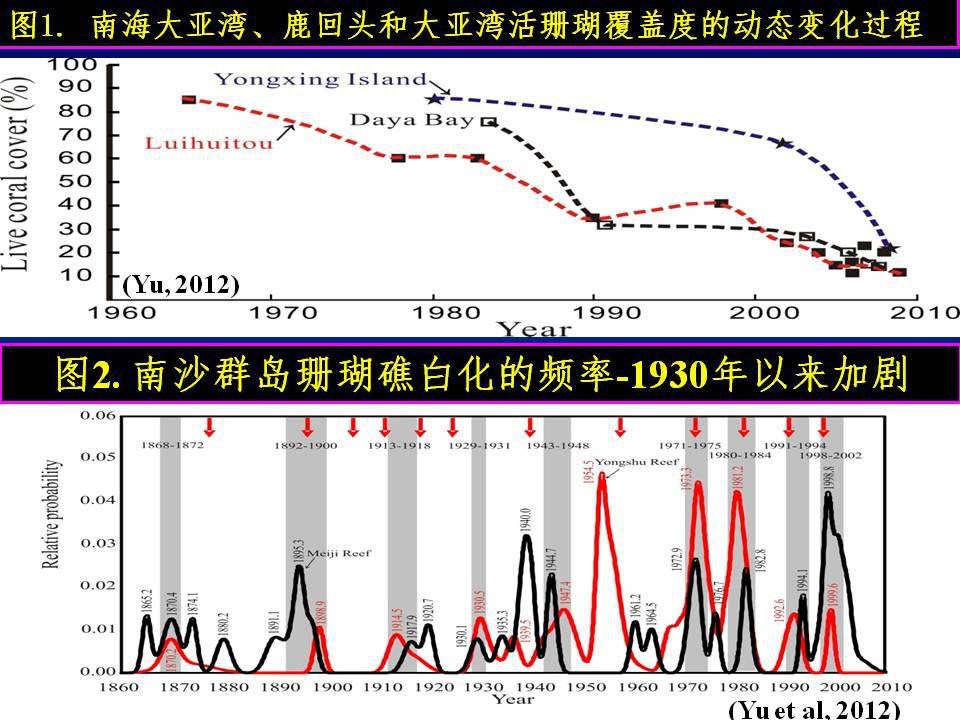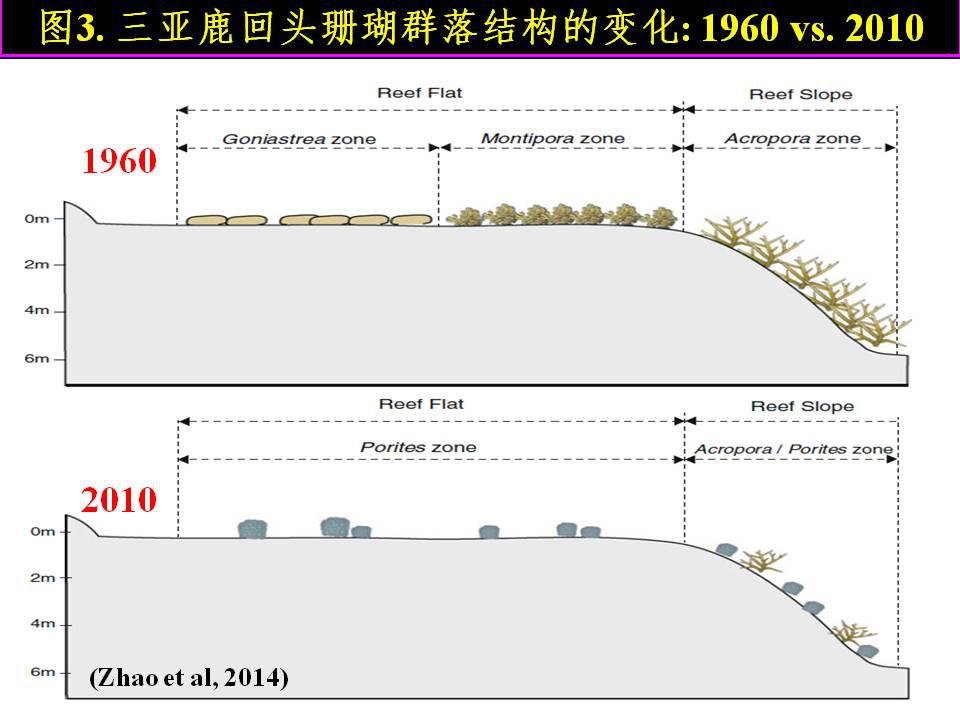继2013年刊载南海所陈天然等关于富营养化加剧大亚湾珊瑚的生物侵蚀成果之后,《Coral Reefs》近日再次报道南海所赵美霞等关于珊瑚年龄结构指示珊瑚礁生态演变过程和现状的论文[Zhao et al. 2014. Age structure of massive Porites lutea corals at Luhuitou fringing reef (northern South China Sea) indicates recovery following severe anthropogenic disturbance. Coral Reefs, 33: 39-44]。该文根据块状滨珊瑚的年龄结构,揭示研究区域鹿回头岸礁自被划入国家级珊瑚礁自然保护区以来(至2010年),正显现出恢复的迹象。《Coral Reefs》是珊瑚礁研究领域的专业刊物(影响因子为3.662)。
近10多年来,南海所珊瑚礁及其环境记录学科组在珊瑚礁现代过程方面开展了较为系统的研究,累计发表22篇SCI论文。相继揭示了:1)南海珊瑚礁的生态现状, 和几个典型礁体活珊瑚覆盖度在过去50年来的退化幅度(>80%); 2)珊瑚共生虫黄藻密度对珊瑚白化的种间差异的控制作用, 密度大的珊瑚不容易白化; 3)疾病对西沙群岛永兴岛珊瑚礁生态现状的负面影响;4)珊瑚在过去300年来的年平均钙化率过程和以及阶段性发生的白化事件, 1930年以来南沙群岛珊瑚白化的频率加剧; 5)南海珊瑚礁对大气碳循环的贡献具有季节差异, 但至少在夏季是大气CO2的源; 6)相对高纬度珊瑚礁(群落)对极端气候事件和人类活动的响应规律。
这些研究相继得到国家自然科学基金重点项目(40231009, 40830852),国家杰出青年科学基金项目(41025007)和国家重大科学研究计划项目(2013CB956100)等的资助。


附件: 珊瑚礁及其环境记录学科组发表的珊瑚礁现代过程方面的22篇SCI论文
(1) Zhao MX et al. (2014). Age structure of massive Porites lutea corals at Luhuitou fringing reef (northern South China Sea) indicates recovery following severe anthropogenic disturbance. Coral Reefs, 33(1): 39-44
(2) Song YX et al. (2014). Past 140-year environmental record in the northern South China Sea: evidence from coral skeletal trace metal variations. Environmental Pollution, 185: 97-106.
(3) Zhao MX et al. (2013). Coral communities of the remote atoll reefs in the Nansha Islands, southern South China Sea. Environ Monit Assess, 185: 7381-7392
(4) Chen TR et al. (2013). Increasing temperature anomalies reduce coral growth in the Weizhou Island, northern South China Sea. Estuarine, Coastal and Shelf Science 130, 121-126.
(5) Chen TR et al. (2013). Macrobioerosion in Porites corals in subtropical northern South China Sea: a limiting factor for high-latitude reef framework development. Coral Reefs, 32:101-108.
(6) Song YX et al. (2013). Vibrational spectroscopic characterization of growth bands in Porites coral from South China Sea. Spectrochimica Acta Part A: Molecular and Biomolecular Spectroscopy 112, 95-100.
(7) Yu KF et al. (2012). Recent massive coral mortality events in the South China Sea: was global warming and ENSO variability respon sible? Chemical Geology, 320-321: 54-65.
(8) Yu KF. (2012). Coral reefs in the South China Sea: their responses to and records on past environmental changes. Science China-Earth Sciences, 55(8): 1217-1229
(9) Zhao MX et al. (2012). Long-term decline of a fringing coral reef in the northern South China Sea. Journal of Coastal research, DOI: 10.2112/JCOASTRES-D-10-00172.1.
(10) Shi Q et al. (2012). Two centuries-long records of skeletal calcification in massive Porites colonies from Meiji Reef in the southern South China Sea and its responses to atmospheric CO2 and seawater temperature. Science in China-D series, 2012, 55(1): 1-12.
(11) Shi Q et al. Black disease (Terpios hoshinota): A probable cause for the rapid coral mortality at the northern reef of Yongxing Island in the South China Sea. AMBIO, 2012, 41(5): 446-455.
(12) Yan HQ et al. (2011). Coral reef ecosystem in the South China Sea as a source of atmospheric CO2in summer. Chinese Science Bulletin 56, 676-684.
(13) Li S et al. (2011). Assessing 2007 AD coral bleaching with symbiotic zooxanthellae density and satellite remote sensing data in Nansha Islands, South China Sea. Chinese Science Bulletin, 2011, 56, doi: 10.1007/s11434-010-0000-2.
(14) Chen TR et al. (2011).P/Ca in coral skeleton as a geochemical proxy for seawater phosphorus variation in Daya Bay, northern South China Sea. Marine Pollution Bulletin, 62(10), 2114-2121
(15) Chen TR et al. (2011).Anomalous Ba/Ca signals associated with low temperature stresses in Porites corals from Daya Bay, northern South China Sea. Journal of Environmental Sciences, 23(9), 1452-1459
(16) Chen TR et al. (2010). Heavy metal pollution recorded in Porites corals from Daya Bay, northern South China Sea. Marine Environmental Research 70, 318-326.
(17) Chen TR et al. (2009). Twenty-five years of change in scleractinian coral communities of Daya Bay (northern South China Sea) and its response to the 2008 AD extreme cold climate event. Chinese Science Bulletin 54, 2107-2117.
(18) Shi Q et al. (2009). Estimate of carbonate production by scleractinian corals at Luhuitou fringing reef, Sanya, China. Chinese Science Bulletin 54, 696-705.
(19) Li S et al. (2008). Interspecies and spatial diversity in the symbiotic zooxanthellae density in corals from northern South China Sea and its relationship to coral reef bleaching. Chinese Science Bulletin 53, 295-303.
(20) Zhang QM et al. (2006). Status monitoring and management strategy of Luhuitou fringing reef of Sanya, Hainan, China. Chinese Science Bulletin, 51 (s2) : 81-88
(21) Zhang QM, (2004). Coastal bio-geomorphologic zonation of coral reefs and mangroves and tide level control. Journal of Coastal Research, Special Issue, 43: 202-211.
(22) Zhang QM, (2001). The biogeomorphology of Luhuitou fringing reef of Sanya City, Hainan Island of China. Chinese Science Bulletin, 46 (Supp):97-102.
